Japan Wood Products
Prices
Dollar Exchange Rates of
10th September 2013
Japan Yen 99.58
Reports From Japan
Bank of Japan supports consumption tax increase
In a recent statement the governor of the Bank of Japan
(BoJ) added his voice to those calling on the government
to go ahead with the increase in consumption tax
scheduled for next April. The basis for this
recommendation from the BoJ is their assessment that the
economy is strong enough and that consumers have
already accepted the concept of and need for the increase.
The BoJ policy board has determined that the Japanese
economy is recovering and the board declared it will
continue to aim for the 2 percent inflation over two years.
The BoJ statement can be found at:
http://www.boj.or.jp/en/announcements/release_2013/k13
0905a.pdf
Japan's economy is recovering helped by stabilisation of
overseas economies says the BoJ, mainly because exports
have been picking up and business fixed investment has
strengthened on the back of improved corporate profits.
Public investment in Japan continues to increase and the
sustained investment in housing is providing support to
growth.
Private consumption is a pillar of the current economic
strengthening as there has been some improvement in
employment opportunities, especially for the younger
generation, and incomes are improving.
Manufacturers have interpreted these developments as
reflecting improvements in domestic and international
demand so are raising industrial production.
Economic outlook favourable as deflation ends
The BoJ statement says: „on the price front, the year-onyear
rate of change in the consumer price index (CPI, all
items less fresh food) is in the range of 0.5-1.0 percent so
inflation expectations appear to be rising‟.
With regard to the outlook, Japan's economy is expected to
continue a moderate recovery and the year-on-year rate of
increase in the CPI is likely to rise gradually.
The BoJ confirmed it would continue with its quantitative
and qualitative monetary easing as long as it was
necessary to achieve its 2 percent inflation target.
Mismatch, Consumer confidence down while BoJ
reports economy strengthening
The Japanese Cabinet Office released August Consumer
Confidence data on 9 September. The Consumer
Confidence index fell to 43.0 marking three consecutive
months‟ of decline. A reading below 50 indicates
consumer pessimism. The index for Willingness to buy
durable goods also fell in August.
For the complete Cabinet Office survey data see:
http://www.esri.cao.go.jp/en/stat/shouhi/shouhi-e.html
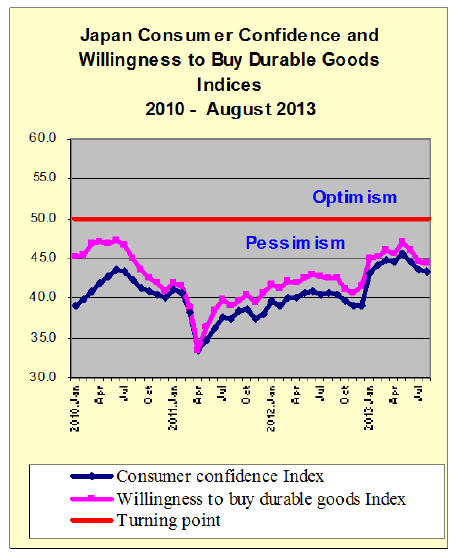
Analysts suggest that Japanese consumers, while seeing
improvement in the financial markets, are yet to be
convinced there is growth in the real economy as reflected
in job creation and rising wages. The Cabinet Office has
acknowledged that the improvement seen in consumer
sentiment has stalled.
Japan struggles to make up time in TPP talks
Representatives of the Japanese government and private
sector have been actively participating in the negotiations
for the Trans-Pacific Partnership (TPP) initiative and have
been working hard to make up for their late participation
in the talks.
The countries negotiating the TPP (Australia, Brunei,
Canada, Chile, Japan, Malaysia, Mexico, New Zealand,
Peru, Singapore, the United States and Vietnam) have
agreed to declare their uncontroversial tariff eliminations
by mid September to keep within the four-stage timetable
for concluding the framework agreement by October.
Japan will hold bilateral talks on the elimination of tariffs
with six TPP countries through mid-September in an
attempt to make up for its late start in the negotiation
process, say government sources.
The first of several bilateral talks will begin on 18
September with Australia, Canada, Chile, Peru, the United
States and Vietnam. This will be followed by talks with
Brunei, Malaysia, Mexico, New Zealand and Singapore.
Yen weakens on revision of US GDP and improved
global economies
The yen weakened marginally against the dollar in late
August after the US announced revised GDP figures for
the second quarter indicating growth was almost double
the initial figure for the quarter.
The continued slide in the yen dollar exchange was also
fuelled by signs of economic improvement in the major
developed markets such that demand diminished for
refuge assets such as the yen.
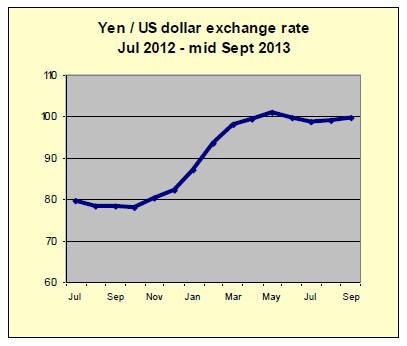
Consumers see end to house price deflation
July housing starts in Japan increased 12.0 percent year on
year but were only marginally higher than in June. House
building companies have reported an almost 14 percent
rise in orders for new homes compared to levels in July
last year.
See data at www.mlit.go.jp/toukeijouhou/chojou/state.
htm

Analysts say that behind the steady growth in housing
starts is the ease at which low fixed rate interest mortgages
can be obtained and concern on the part of buyers that
house prices will not be falling any further after a decade
of almost uninterrupted declines.
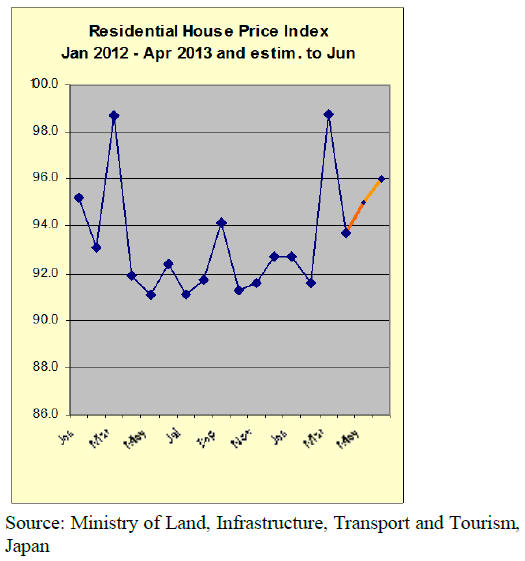
Trade news from the Japan Lumber Reports (JLR)
Publication of the Japan Lumber Reports (JLR) for mid
September is delayed because of a public holiday. Updates
from the JLR will be provided in the next market report
from ITTO
Steady climb in plywood prices arrested
The steady increase in plywood prices over the past
months eased in August as stock holdings by
manufacturers and traders had risen. However, prices
began climbing again in September.
The rise in stocks was partly because of the lull in building
activity during the holiday month of August and because
the pace of building work, particularly in the disaster hit
areas, had slowed because of a shortage of skill builders
and problems with supplies of non-wood building
products.
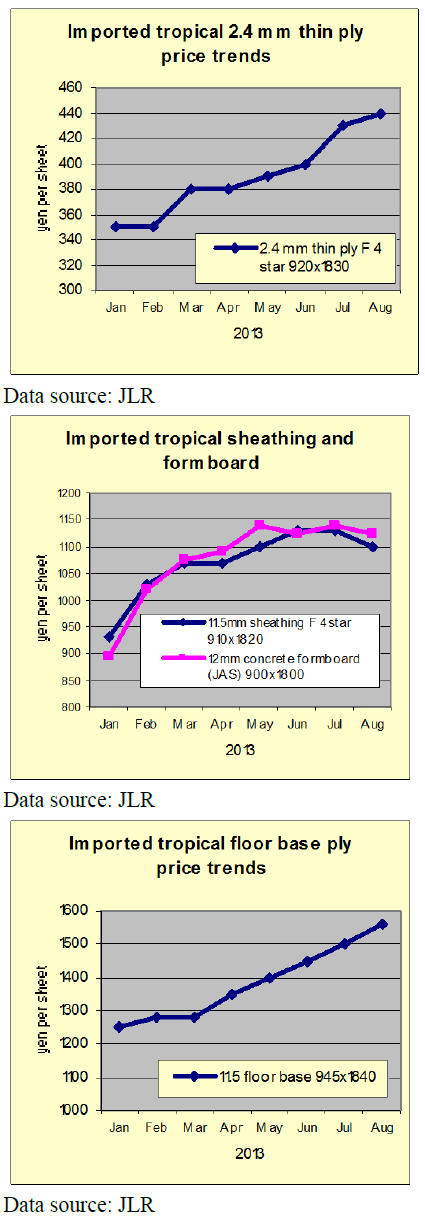
Japan’s furniture imports
July 2013 furniture imports
The source and value of Japan‟s office, kitchen and
bedroom furniture imports for July 2013 are shown below.
Also illustrated is the trend in imports of office furniture
(HS 9403.30), kitchen furniture (HS 9403.40) and
bedroom furniture (HS 9403.50) between 2009 and June
2013.
Office furniture imports (HS 9403.30)
In July 2013 Japan‟s imports of office furniture surged
over 50% from levels in June the top four suppliers in July
were China (31%), Poland (18%), Portugal (12%) and
Malaysia (9%). July imports totalled yen 213 million close
to the second highest monthly import for 2013 with around
52% being provided by exporters in Asia and 46% from
exporters in the EU.
China‟s July office furniture exports to Japan were
marginally up on levels in June while Japan‟s imports of
office furniture from Malaysia and Indonesia almost
doubled. Imports from Poland, Portugal, Italy and the
USA showed double digit growth.

Kitchen furniture imports (HS 9403.40)
Asian suppliers provided over 90% of all kitchen furniture
imports by Japan in July according to figures from Japan‟s
Ministry of Finance. July imports at yen 1,153 million,
were around 15% higher than in June and the highest level
for 2013.
The top three suppliers in July were Vietnam, Philippines
and Indonesia, together accounting for over 70% of all
kitchen furniture imports. If imports from China are added
to the amount from the top three suppliers then some 86%
of all kitchen furniture imports are accounted for.
Imports from countries outside of Asia remain small and
imports from Germany, usually one of the larger EU
suppliers, fell by 40% while imports from Italy and the US
were up.
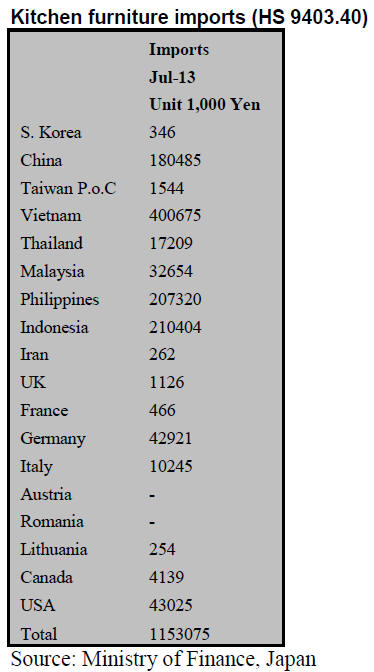
Bedroom furniture (HS 9403.50)
Japan‟s imports of bedroom furniture were close to yen 2
bil. every month up until June when they fell around 16%
to yen 1,582 million but in July imports improved by 16%
to yen 1.8 bil.
Malaysia‟s exports of bedroom furniture to Japan surged
45% in July closely followed by the 20% jump in imports
from Thailand. But, the number one supplier of bedroom
furniture remains China followed by Vietnam, Malaysia
and Thailand.
China‟s exports of bedroom furniture to Japan account for
56% of Japan‟s total imports of bedroom furniture. Asian
suppliers provided 93% of Japan‟s July imports of
bedroom furniture.
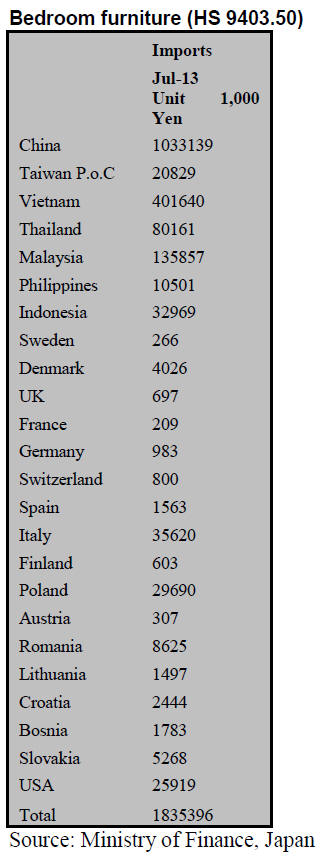
Source of information on import tariffs in Japan
The Japan Customs website has information on duties and
taxes.
See:http://www.customs.go.jp/english/summary/tariff.htm
Specific tariff rates are regularly amended and the latest
available on the Japan Customs website can be found at:
http://www.customs.go.jp/english/tariff/2013_4/data/i2013
04e_44.htm
and
http://www.customs.go.jp/english/tariff/2013_4/data/i2013
04e_94.htm
Goods imported into Japan are subject to Customs duty
and consumption tax. In addition to consumption tax,
certain other internal taxes (liquor tax, tobacco tax, etc.)
are also applicable to dutiable imported goods.
Tariff (Duty Rates) System for Commercial Goods
The harmonized classification schedule annexed in the
Customs Tariff Law sets out both the classification and the
corresponding Customs duty rate (called the General Rate)
of particular products.
The actually applied rate, however, is not necessarily this
General Rate. The Temporary Tariff Measures Law sets
out the Temporary Rate for certain products, which in
these cases prevails over the General Rate.
In addition, when the Customs duty rate in the WTO
Concession Schedule (so-called WTO Rate) or the rate set
forth by the Economic Partnership Agreement (so-called
EPA Rate) is lower than the General Rate (or the
Temporary Rate, if applicable), the WTO rate or EPA rate
is applied.
In short, the applied rate is the lower of the WTO rate, the
Singapore rate, and the General (or the Temporary) rate.
For designated developing countries, the Customs Tariff
Law and the Temporary Tariff Measures Law also provide
Preferential Rate (GSP) which is applicable to certain
products and naturally lower than any of the above rates.
Most of the Customs duties are assessed at ad valorem
rates, which are applied to the dutiable value of the
imported goods. Some items including certain alcoholic
beverages and cereals, however, are dutiable at a specific
rate, and others are dutiable at a compound rate such as a
combination of both ad valorem and specific rates.
For more see:
http://www.customs.go.jp/english/summary/tariff.htm
|